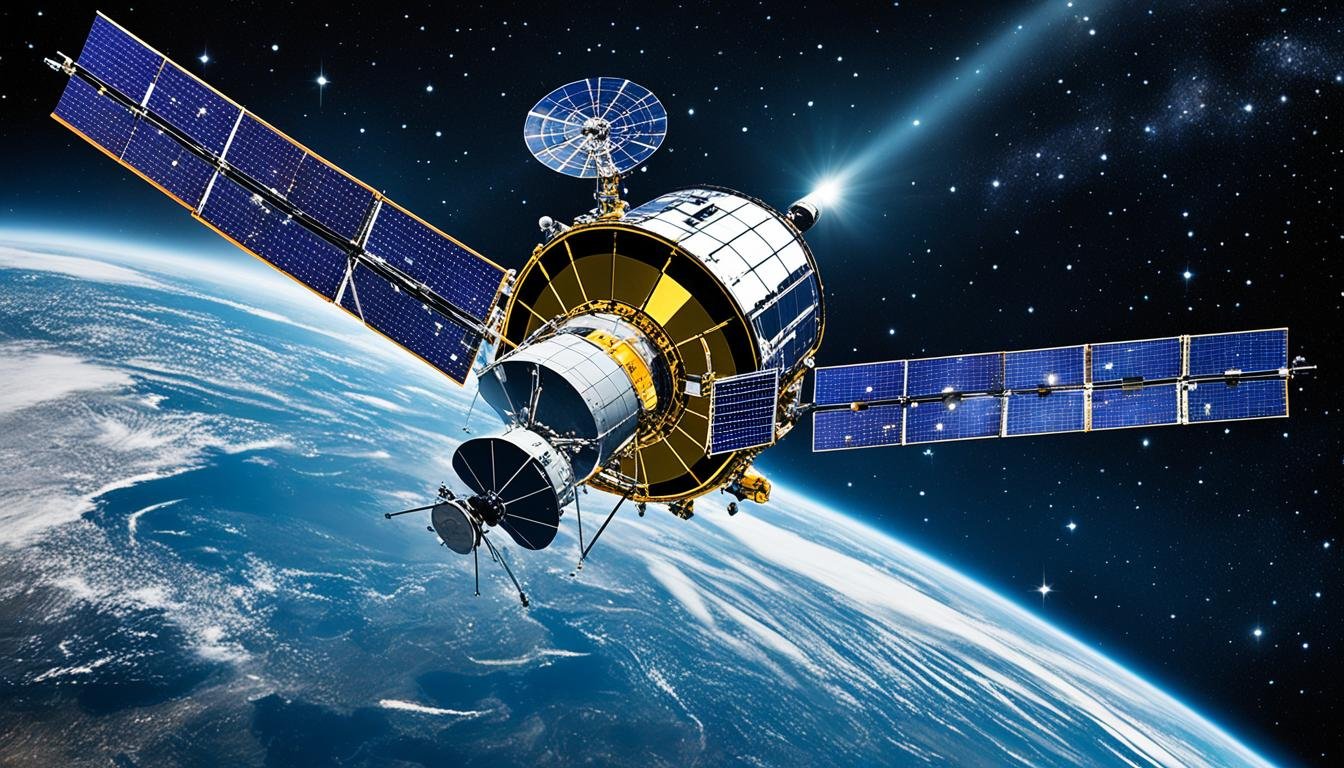Space exploration has always sparked our curiosity. It’s key for scientific discovery and human progress. Innovations in technology are vital for space travel and understanding the universe.
Rocket technology is at the heart of space exploration. Now, with reusable rockets and better manufacturing, space travel is cheaper and easier. Robots have opened new doors for us, and new propulsion methods like nuclear propulsion and solar sails speed up trips to other planets.
Space telescopes and remote sensing have changed how we see the universe. Artificial intelligence and machine learning help us make sense of the vast data from space. These technologies drive the progress in space exploration. Keeping up with research and supporting talented people is key to exploring space further.
Key Takeaways
- Space technology is crucial for advancing scientific research and understanding the universe.
- Innovations in rocket technology make space travel more accessible and affordable.
- Robotic missions and advanced propulsion systems help us explore distant celestial bodies.
- Space-based telescopes and remote sensing have transformed our view of the cosmos.
- Artificial intelligence and machine learning are vital for analyzing data from space missions.
Introduction to Space Technology and Scientific Research
Space exploration has been a key part of humanity’s quest for knowledge. By exploring space, scientists use many tools to learn about stars and planets. This helps us understand the universe better.
Overview of Space Exploration’s Impact on Scientific Discovery
Space exploration has greatly expanded our knowledge of the universe. It lets us study planets and solve mysteries like black holes and dark matter. This work also helps us look for life beyond Earth and understand how life began.
The Importance of Investing in Space Technology for Scientific Advancements
Space exploration pushes us to be more creative, leading to new discoveries in fields like astrobiology and astrochemistry. These advances help us understand the universe and improve life on Earth. So, investing in space technology and exploration is key to growing our scientific understanding.
“Space exploration acts as a powerful engine for innovation, inspiring us to push the boundaries of what is possible and making groundbreaking discoveries that can benefit all of humanity.”
Advancements in Rocket Technology

Rocket technology has changed a lot since the early days of space travel. Now, we can go farther and explore more thanks to new engines, materials, and fuel efficiency. These changes have made space travel possible.
Evolution of Rocket Propulsion Systems for Space Exploration
Improvements in rocket propulsion have helped us explore space. New engines and systems have made launch vehicles and spacecraft better. Now, we’re seeing new technologies like reusable rockets and efficient manufacturing. These changes could make space travel cheaper and more accessible.
Reusable Rockets and Efficient Manufacturing for Cost-Effective Space Travel
Reusable rockets have changed space travel. They let us reuse parts, which could make space travel cheaper. With better manufacturing, space travel might become more affordable and sustainable. This could open space to more people for science, business, and fun.
Rocket technology is key to space exploration. From the engines that send spacecraft to orbit to systems that move in space, it’s vital. As we keep improving rockets, we’ll go on bigger missions and make new discoveries. This will help us learn more about the universe and our place in it.
Pioneering with Robotics
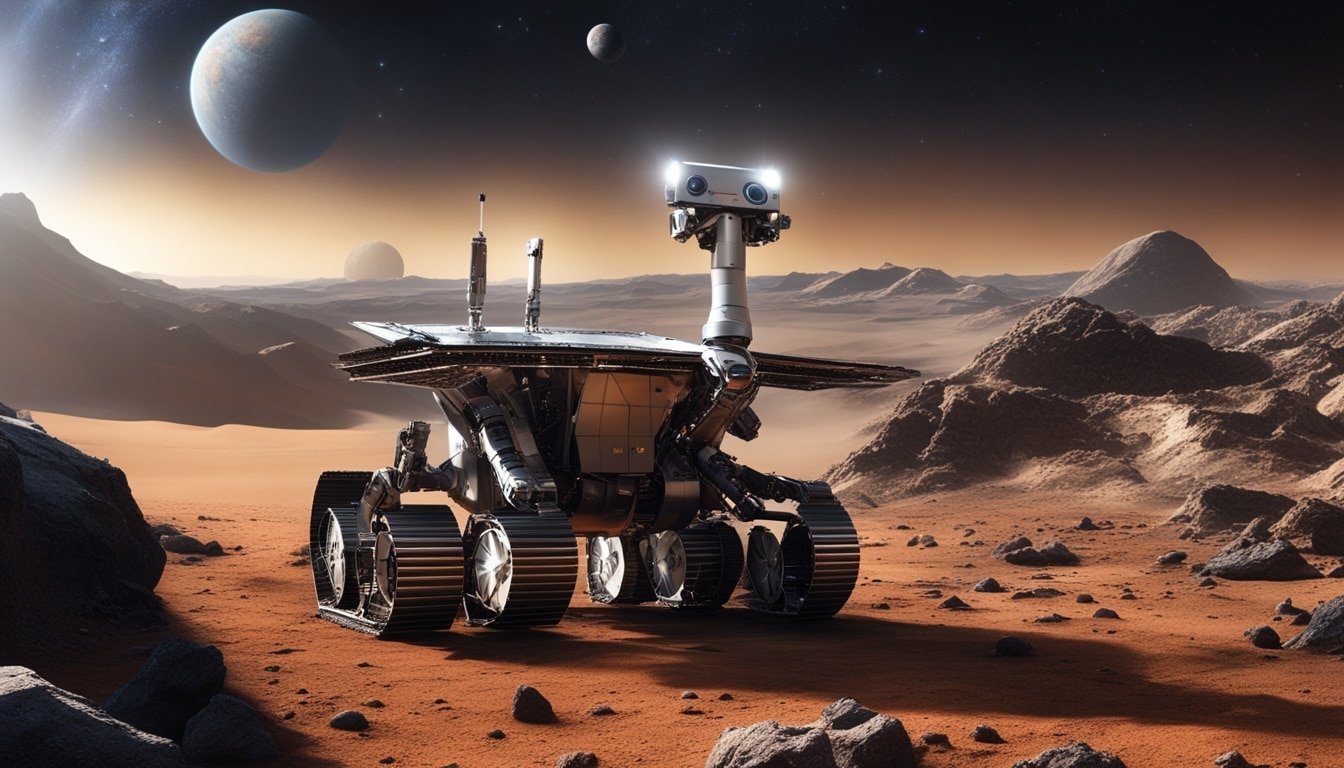
Before sending humans into space, robots have led the way. Rovers like Opportunity and Spirit have greatly expanded our knowledge of Mars. Spacecraft like Voyager have gone into interstellar space, carrying a golden record of humanity’s achievements.
Unmanned missions let us take risks safely. They explore dangerous places and gather important data. This helps us prepare for future missions with robots and humans.
Robotic Pioneers and Their Achievements
- The Mars rovers Opportunity and Spirit have explored the surface of the Red Planet, providing unprecedented insights into its geology and climate.
- Voyager spacecraft have ventured into the outer solar system and beyond, carrying a golden record that represents humanity’s achievements and discoveries.
- Unmanned missions have allowed for the exploration of hazardous environments, such as the surface of Venus and the atmosphere of Jupiter, without risking human lives.
| Robotic Mission | Achievements | Significance |
|---|---|---|
| Mars Rovers (Opportunity and Spirit) | Extensive exploration of the Martian surface, providing insights into the planet’s geology and climate. | Expanded our understanding of Mars and paved the way for future human exploration. |
| Voyager Spacecraft | Venturing into interstellar space, carrying a golden record representing humanity’s achievements. | Showcased the capabilities of robotic technology and provided a lasting record of human civilization. |
| Unmanned Missions | Exploration of hazardous environments, such as the surface of Venus and the atmosphere of Jupiter, without risking human lives. | Gathered vital data and insights that would have been too dangerous for human missions. |
As we explore space further, robots will be key in uncovering the universe’s secrets. They will help prepare for human spaceflight.
“Robotics has the potential to revolutionize space exploration by allowing us to gather data, explore hazardous environments, and push the boundaries of human knowledge without risking lives.”
Advanced Propulsion
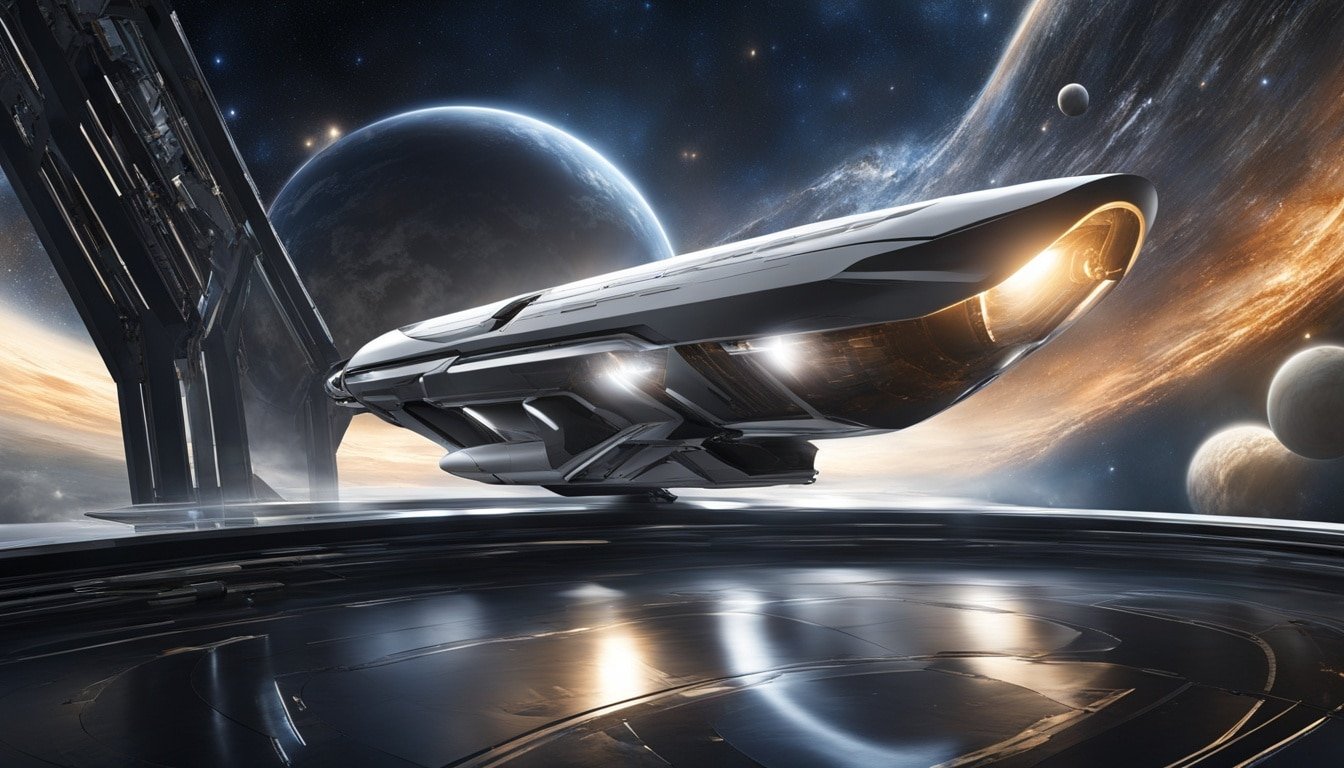
The push for deeper space exploration is growing fast. Traditional rockets have limits in speed and range, holding us back from exploring far. But, new advanced propulsion technologies could change the game for space travel and interplanetary exploration.
Nuclear Propulsion, Solar Sails, and Ion Thrusters for Faster Space Travel
Scientists are looking into new ways to make space travel faster and more efficient. Nuclear propulsion uses the power of nuclear reactions to speed up spacecraft. Solar sails use sunlight to push spacecraft forward, without needing fuel. And ion thrusters use charged particles for precise control and speed.
Enabling Exploration of Distant Celestial Bodies with Innovative Propulsion
These new propulsion systems could open up the universe to us. They make trips longer distances shorter and safer. This means we can explore more of our solar system and beyond, finding new things and learning more about space.
The work in aerospace engineering is making in-space propulsion and spacecraft propulsion better. These advances will help shape the future of space exploration and our understanding of the universe.
“The exploration of the universe is the exploration of the human mind.”
– Neil deGrasse Tyson
Remote Sensing and Space Telescopes

Space exploration has changed a lot thanks to new tech in remote sensing and space telescopes. Telescopes like the famous Hubble Space Telescope and the new James Webb Space Telescope have given us amazing views of space. They help us learn more about exoplanets and other cosmic events.
The Hubble and James Webb Space Telescopes’ Contributions
The Hubble Space Telescope changed astronomy when it launched in 1990. It gave us clear images and data that let scientists study far-off galaxies and how stars and planets form. The James Webb Space Telescope, launched in 2021, is even more advanced. It helps us explore exoplanets and the early universe.
Future Advancements in Observational Capabilities
- New remote sensing tech will help find and study exoplanets. It might even show if they can support life.
- Next-gen space telescopes will look into mysteries like black holes and dark matter. They’ll help us learn more about the universe.
- New tools will make space exploration and scientific research better. They’ll lead to new tech and engineering in space.
We’re always improving space technology. The future looks bright for discovering the universe’s secrets and understanding space better.
Data Analysis and Artificial Intelligence

Space missions generate a huge amount of data, which is hard to handle. But, thanks to artificial intelligence (AI) and machine learning, we can now process and understand this data better.
AI tools are key for finding patterns in the data from space missions. They help predict space events and make missions more efficient. This makes exploring space more effective.
Roles of AI and Machine Learning in Processing Space Mission Data
AI and machine learning have changed how we analyze space data. They go through huge amounts of data to find important insights and trends. This is something humans can’t do on their own.
These technologies are vital for scientific research and aerospace engineering. They help us understand complex data and patterns.
Optimizing Mission Operations and Identifying Patterns with AI
As we explore space more, making missions efficient and finding important patterns in data is crucial. AI systems can look at data in real-time, spot problems, and suggest how to fix them. They also find patterns we might have missed, leading to new discoveries.
“The future of space exploration lies in our ability to make sense of the vast amounts of data collected during missions. Artificial intelligence is the key to unlocking the full potential of this information and pushing the boundaries of our understanding of the cosmos.”
AI and machine learning will play an even bigger role in data analysis and space mission operations as they get better. These tools help scientists and engineers find new insights, make missions more efficient, and speed up scientific discovery in space.
Space Technology
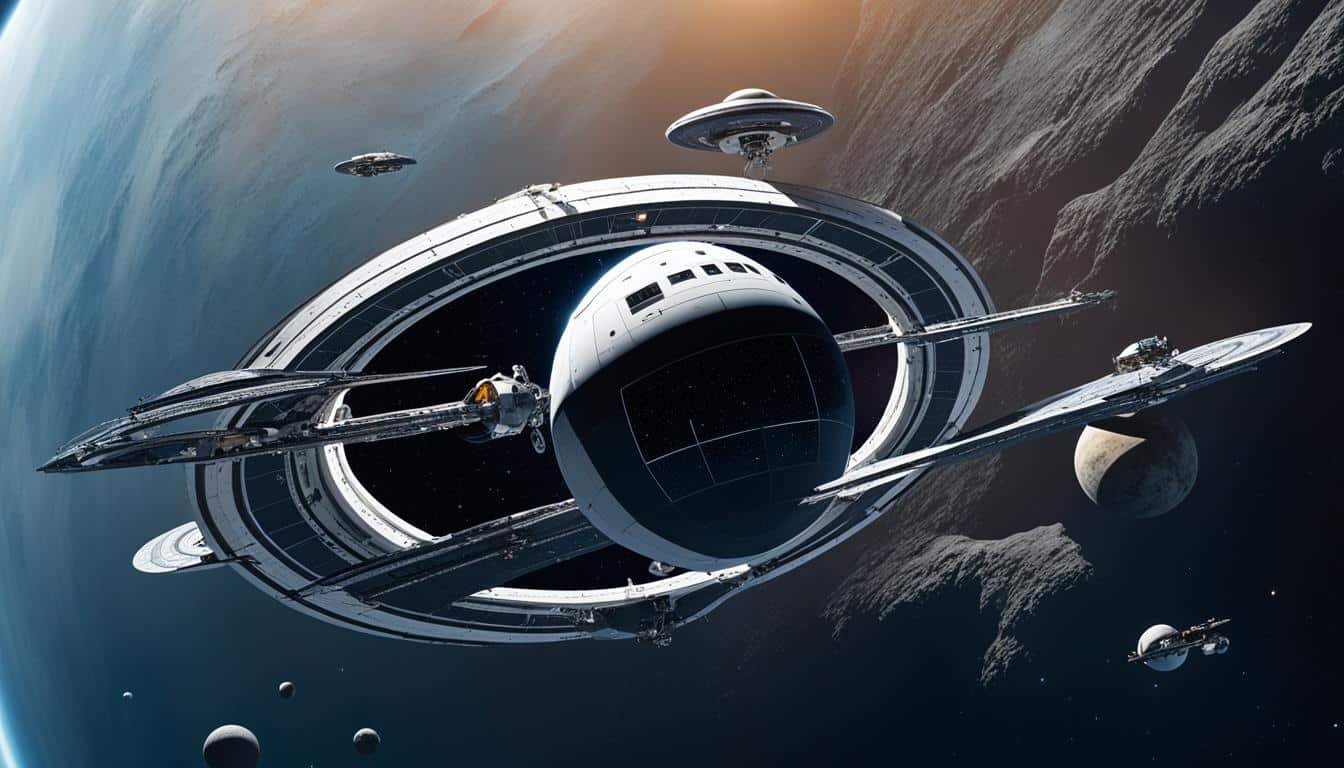
Space technology has led to some of humanity’s biggest achievements in space. It has helped us overcome the challenges of reaching other planets and has given us the tools for major scientific discoveries. This innovation has pushed us forward in our journey through space.
Unlocking the Secrets of the Universe
Space technology has been key in uncovering the universe’s secrets. It has improved rocket technology, robotics, and remote sensing. This has let us explore more and learn new things about space.
Tools like the Hubble and James Webb Space Telescopes have changed how we see the universe. They’ve helped us learn about exoplanets, black holes, and where the universe came from.
Embracing the Spirit of Innovation
To keep exploring space and making new discoveries, we need to keep innovating. We should invest in research, work together between government and private sectors, and support top aerospace engineers. This will help us face the challenges of space.
By using space technology, we can learn more about the universe and make our mark in space.
“The path of innovation is never easy, but it is the only way to expand the boundaries of human knowledge and reach for the stars.”
Space Station Research and Technology
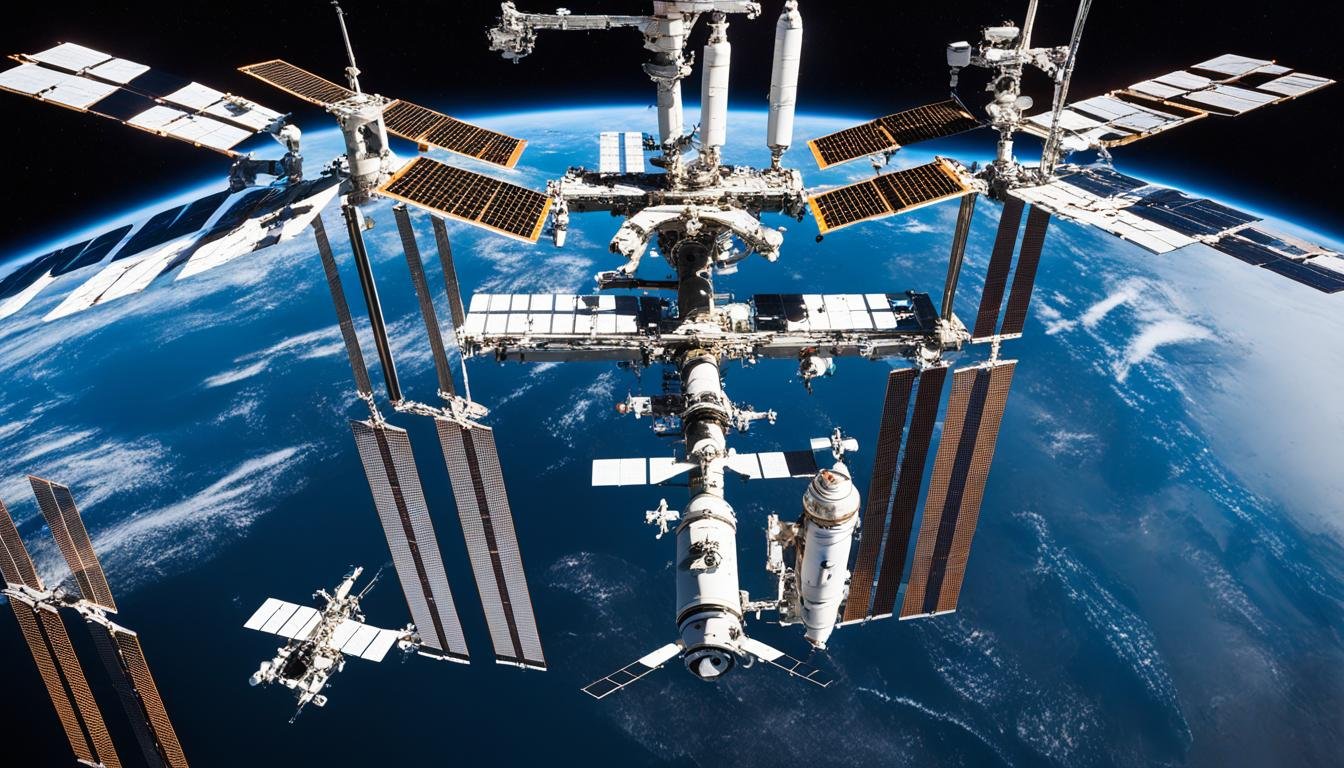
The International Space Station (ISS) is a leading scientific lab in space. It hosts many research and technology projects across different fields. This unique place in space lets us study things we can’t on Earth. It helps us learn more about the universe and how our bodies work in space.
The International Space Station as a State-of-the-Art Microgravity Laboratory
The ISS is a top-notch microgravity laboratory. Scientists from all over the world work together here. They study things like astrophysics, combustion science, microbiology, and life science in space. This research could lead to big discoveries that help us in many ways.
Exploring Scientific Disciplines on the Orbiting Research Platform
- Astrophysics: Studying the formation and evolution of celestial bodies, the nature of dark matter, and the mysteries of the universe.
- Combustion Science: Investigating the behavior of flames and combustion processes in the absence of gravity, with applications in energy efficiency and safety.
- Microbiology: Exploring the growth and behavior of microorganisms in the unique microgravity environment, with implications for human health and space-based research.
- Life Science: Examining the physiological and psychological effects of long-term exposure to microgravity on the human body, paving the way for future deep-space exploration.
Research on the ISS helps us learn more about the world and improves technology. It also helps create a strong low Earth orbit economy. This can lead to new technologies that help us on Earth too.
“The International Space Station is a unique laboratory that allows us to push the boundaries of scientific understanding and technological innovation in ways that are simply not possible on Earth.”
| Scientific Discipline | Research Focus on the ISS | Potential Impacts |
|---|---|---|
| Astrophysics | Studying the formation and evolution of celestial bodies, the nature of dark matter, and the mysteries of the universe. | Advancements in our understanding of the cosmos and the development of space-based observational technologies. |
| Combustion Science | Investigating the behavior of flames and combustion processes in the absence of gravity, with applications in energy efficiency and safety. | Improvements in fuel efficiency, fire safety, and the development of more sustainable energy technologies. |
| Microbiology | Exploring the growth and behavior of microorganisms in the unique microgravity environment, with implications for human health and space-based research. | Advancements in understanding the impact of space travel on the human microbiome and the development of novel biotechnologies. |
| Life Science | Examining the physiological and psychological effects of long-term exposure to microgravity on the human body, paving the way for future deep-space exploration. | Insights into the human body’s adaptation to extraterrestrial environments and the development of countermeasures to mitigate the challenges of space travel. |
Economic and Societal Benefits of Space Exploration
Space exploration brings more than just scientific discoveries. Many technologies developed for space have made a big impact on Earth. For example, GPS and satellite tech have changed how we travel, farm, and find our way around.
The space travel industry is growing, with both government and private companies involved. This growth has created new jobs in engineering and support services. It’s driving economic growth and encouraging innovation.
Technological Spin-Offs and Their Applications on Earth
- GPS technology, once for the military, now helps with navigation, logistics, and finding locations worldwide.
- Satellite tech, crucial for space missions, has improved weather forecasting, disaster response, and monitoring the environment.
- Emergency beacons from space have saved lives, helping to locate and rescue people in danger on land or at sea.
Fostering International Cooperation and Inspiring Future Generations
Space exploration also helps countries work together and build trust. Nations worldwide partner on missions and projects. This teamwork not only strengthens global ties but also motivates young people to study STEM fields.
This ensures the growth of human knowledge and exploration. It’s a shared journey that brings the world closer together.
“Space exploration not only pushes the boundaries of scientific discovery but also brings the world together in a shared quest for knowledge and understanding.”
The Future of Space Technology and Exploration

Looking ahead, the future of space exploration is full of potential. We need to keep investing in future space technology and future space exploration. By working together, we can create new solutions. These will help us go deeper into space and learn more about the universe.
It’s also key to support the next generation of bright minds in STEM fields. This will keep space exploration moving forward. By encouraging young people, we can keep pushing the limits of what we can do in space.
Investing in Research and Development for Continued Progress
The work in research and development of space technology and space exploration has led to big leaps. We need to keep investing to overcome future challenges. By focusing on innovation and scientific advancements, we can improve aerospace engineering and technology development. This will open new doors for working together globally and exploring the unknown.
Nurturing Bright Minds for Exploring the Final Frontier
The future of space exploration depends on the next generation of bright minds. By supporting STEM education, we can encourage young people to join the space industry. This will create a strong group of people ready to lead space missions and space travel. With ongoing support, we can uncover the universe’s secrets and keep moving forward.
Also Read : What Are The Benefits And Risks For Using Biotechnology ?
Conclusion
Space exploration has driven scientific discovery and tech growth. It has captured our imagination and expanded our universe knowledge. Advances in rocket tech and robotics have led to new propulsion systems and space telescopes.
Using data analysis and artificial intelligence, we process vast space mission info. This helps improve operations and find new insights. The International Space Station is now a top-notch lab in space, supporting important research.
Space exploration brings big benefits to our economy and society. It leads to new tech and helps us work together globally. Looking ahead, we need to keep investing in research and supporting young talents. This will help us keep exploring and growing in space.
FAQs
Q: What is the role of space technology in scientific research?
A: Space technology plays a crucial role in scientific research by enabling scientists to explore outer space, conduct space missions, study celestial bodies, and gather data for various research purposes.
Q: How does NASA contribute to space technology?
A: NASA, the National Aeronautics and Space Administration, is a leading agency in developing and implementing advanced space technologies for exploration, research, and innovation.
Q: What are some common technology areas used in space research?
A: Common technology areas used in space research include spacecraft design, propulsion systems, satellite communication, robotics, astronautics, and various manufacturing technologies.
Q: What is the significance of technology transfer in space science?
A: Technology transfer in space science involves adapting and applying innovations from space research to other fields such as medicine, environmental monitoring, telecommunications, and more, to benefit society as a whole.
Q: How has space technology contributed to the history of space exploration?
A: Space technology has significantly contributed to the history of space exploration by enabling the first human missions to space, moon landings, space shuttle programs, international collaborations, and advancements in space transportation.
Q: What are some key terms related to high-tech space technology?
A: Some key terms related to high-tech space technology include SpaceX, space vehicles, ground control, rocket engines, antennas, nozzles, habitats, space transportation, and technologies driving exploration.
Q: How has the first woman played a role in space technology?
A: Women have made notable contributions to space technology, with the first woman in space being Valentina Tereshkova in 1963 and subsequent female astronauts participating in various space missions and research programs.
